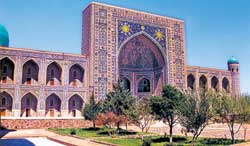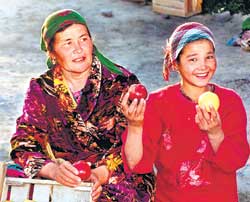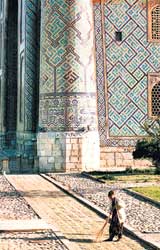
On the golden road to Samarkand~ From Khiva to Issy-Kul : An Islamic journey in the Central Asian heartlands of Timur- Part 2 Travelling out of Tashkent in 1999 was fraught with difficulties of a modern nature; independent travellers were most unwelcome, there was little tourist infrastructure, the police or mafia or both manned innumerable checkpoints, no one spoke English (and I no Uzbek) and permits, letters of introduction and accommodation registration for each night were mandatory. Carrying a rucksack of unreceipted cash was merely icing on the cake. Luckily, a reliable young Armenian driver (no English) materialized and he introduced us, a travelling companion and myself, proudly to his gleaming black 18-year-old Lada, inherited from his grandfather. With rudimentary negotiation, mostly by waving $200 and a mixture of both sign and body language interjected with joviality, we set off south-west to Samarkand. The road was perhaps less than golden, though its surface was good due to the former Soviet Union’s security concerns, but my relief after years of waiting to be heading to such a historic place knew no bounds.
From Tashkent to Samarkand today, the journey is a mere 300 km (5 hours) by road. The land varies from flat to gently undulating, and limitless fields - empty from a recovering temperate winter - rise out to the horizon. Rows of white delicately blossoming apricot and cherry trees and slender birch, willow and poplar trees serenade rural roads. Villages pass by, with scant life peeping out. Though in retrospect it reminds me much of the drier landscape in north-west Pakistan, signs of the different Central Asian culture could be witnessed. Rural houses were unremarkable; village elders (some still in flowing Timurid robes, with gaunt faces and wispy beards) sat on large beds with a coffee table on top, playing board games and sipping tea. Life was slow. Roll over Copernicus! As I neared the gentle greener hills before Samarkand, the memory of Alexander the Great’s own arrival here, his Marcanda, in 329BC drew to mind; he was enamoured by the temperateness of its climate and rippling hills. Perhaps the well known “Golden Road to Samarkand”, a poem coined by poet James Flecker in 1913, was appropriate if it referred now to the beautiful red-gold fading sunlight that bathed one hillside and with it, the tall contemplative statue of Ulugh Beg (1407-1449 AD), Timur’s scholarly grandson and subsequent ruler. He became renowned throughout the Eastern world for what would possibly be the world’s first observatory (3 storeys, 1428 AD) and his advanced mathematical calculations which, years before the more celebrated Copernicus (1473-1543 AD), deduced that the earth revolved around the sun! His findings were verified by Oxford University only 200 years later. The amazing circular grooved gully which guided the 118 foot radius stone sextant (yielding one of the greatest ancient star catalogues) can still be clearly seen. Ulugh Beg, a veritable scholar amongst formidably intelligent Timurid rulers and one more interested in bookfare than warfare (observing “Religions disperse like mist; kingdoms decay but science remains for all time”), was, alas, a victim of his own intellect: conservative Muslims feared that he would undermine the word of God and destroyed this invaluable observatory before his own son killed the astronomer in 1449 and scattered his fellow scientists. The mirror of the world Old Samarkand today is a small, bustling and rather dusty settlement but its chief attractions, the three faceted Registan or “Sandy place” in Old Persian (Central Asia’s most stunning commercial-religious centre and caravanserai of antiquity) with accompanying Ulugh Beg and Tilla Kari medressas, and the Shah Zindeh and Bibi Khanum complexes to name but a few, are still as undeniably riveting as the day when they were completed in the 14-17C AD. “Samarkand” is also one of the most evocative and beautiful names the world has known, one that through the subconscious of ages conjures and radiates awe, with good reason. While a mixture of old Persian and Sogdian for “stone/rock/fort”, it is foreshadowed by its reputation as “Garden of the Blessed”, “The Fourth Paradise” and “Mirror of the World”. Though human origins here are amongst the earliest in Central Asia, stretching back 100,000 years, Samarkand’s golden age was in Timur’s lifetime in 14C AD; it was the culmination of his desire to create the most beautiful and alluring capital the world had seen. To do so, he assiduously gathered the very best of artisans and builders from across his empire, from Aleppo, Damascus, Baghdad, Shiraz, Isfahan, Delhi and eastern China… and on pain of death – regularly exercised by being thrown off minarets or beheaded for the slightest of aberrations – he ordered a multitude of architects, brick-glaziers, ceramic tile and mosaic makers to build. The slightest displeasure had this effect in 1404 when Timur returned unexpectedly early from a campaign to a surprised workforce: “Merely casting an eye upon [the mosque – Bibi Khanum] he [Timur] pronounced against Mohammed Jalad [architect in charge] sentence of death and forthwith they drew him on his face and bound his feet and ceased not dragging him and drawing him over the ground on his face, until in this manner they had torn him into pieces, and Timur took for himself all his servants, children and property.” (-Ibn Arabshah, the disdainful Syrian chronicler of 15C AD whose animosity to Timur was clear in his own chapter headings: “This Bastard Begins to Lay Waste Azerbaijan and the Kingdoms of Irak” and “How the Proud Tyrant was Broken and Borne to the House of Destruction, where He had his Constant Seat in the Lowest Pit of Hell”, quoted in J. Marozzi’s delightful biography on Tamerlane in 2004). Timur then took charge of every detail of construction. An exquisite garden with gold trees The resulting skyline of this city was bathed then in cobalt blues through to shades of turquoise and yellows, with earthy brown walls that still today are framed exquisitely against brilliant blue cloudless Central Asian skies, creating marvels that stunned visiting ambassadors from the west and east for centuries (one, the Egyptian ambassador, was inspired enough to walk a giraffe to Timur’s Court). “The city is surrounded on all sides by many gardens and vineyards…the nobles of the city have their houses amongst these gardens …many streams of water flow through the city… there are many cotton plantations and melon grounds…” quoted the Gonzales de Clavijo in Embassy to Tamerlane 1403-1406, the envoy from the Court of Castille in Spain in his first hand descriptions; his invaluable accounts of feasting in Timur’s court as indeed those of vast tented weddings are eye-opening. With 16 laid out park gardens, fruit orchards interspersed with waterways and fountains, a two storey Palace of Forty Pillars with marbled sculptures, mosaic floors inlaid with ebony and ivory, and Koranic inscriptions visible two miles away, Samarkand was a city with no parallel at a time when many Western cities were, largely, muddied hovels. Witness this extraordinary report from Clavijo : “Standing and set beside this table, was to be noticed a golden tree that simulated an oak, and its trunk was thick as a man’s leg.
This tree reached to the height of a man, and below it was made as though its roots grew from a great dish that lay there. The fruit of this tree consisted in vast numbers of balas rubies, emeralds, turquoises, sapphires and common rubies with many great round pearls of wonderful orient and beauty. These were set all over the tree while numerous little birds, made of gold enamel in many colours, were to be seen perching on the branches. Of these some with their wings open seemed ready to fly…some with closed wings seemed as though they had just alighted on the twigs from flight…some appeared about to eat the fruits of the tree and were pecking with their bills at the rubies, turquoises and other gems…”. Of Silk Road furs and spices In as much as it was gloriously formal, Samarkand was for centuries a renowned caravanserai for tired Silk Road merchants who rested their weary camels and exchanged experiences and goods by firelight, scenes captured in R. Irwin’s dark modern novel An Arabian Nightmare and in countless accounts of bygone explorers. Numerous darker sides to the city prevail, not least the alleged use of thousands of human skulls as construction mortar. But in the great courtyards, furs, linens, leather from Siberia and Tartary, silks, rubies, agates, pearls, spices and musk from China, heady spices of every fragrance from India, glass and metalware from Syria and Asia Minor, and countless lesser but practical items of common trade were bartered. From these, Samarkand’s own fame as a silk weaving and centre grew. “Trade has always been fostered by Timur with a view of making his capital the noblest of cities” observed Clavijo. Perhaps he should have written “All paths meet in Samarkand” for verily Samarkand was an inverted ‘black-hole’ from which no artistic light or artisan could escape and yet, through the vision of a simple nomad, however cruel and accommodating, it/he threw up its wonders in full material splendour for the entire world to see. A turquoise domed timurid legacy Today, the bright restored Registan displays Uzbekistan’s stunning and highly varied Kufic calligraphy. The former Viceroy of India, George Curzon, referred to it in 1888 as “the noblest public square in the world. I know nothing in the East approaching it in massive simplicity and grandeur; and nothing in Europe…”. In a feast of intricacy to the eye, the patterns in blue festoon the numerous arches of the Shir Dar (“Tiger”) and Tilla Kari (“Gold-Covered”) medressas - ancient centres of Islamic teaching - completed well after Timur in 1636 and 1660 respectively. The turquoise, yellow and navy blue tileworks in their geometric designs startle the onlooker while slender sunken alcoves add grace to the soaring buildings, dwarfing me, exactly as Timur had intended. The simple but radiant colour scheme (and the resplendent turquoise onion domes) can be seen in many sites, including the crumbling alleyways and tombs of Shah-Zindeh (“Tomb of the Living King”) where I wandered leisurely amidst ongoing restoration work. A lone young woman artist befriended me in the car park, with an intricately painted watercolour of one wall of the ruins, desperately begging me for a small sum of dollars. After a short negotiation, I soon gave way, embarrassed at my own bargaining, my heart enamoured by her small and beautiful artwork; at her urging we conducted the transaction (a mere $15) inside my taxi as she was fearful of the police. After an uneasy night in a ramshackle but once aspiring Hotel Samarkand, supposedly still reputed if I were to believe the receptionist but with no hot water and a broken dirty bathroom, I ventured at 6 a.m. to Timur’s beautiful mausoleum, Gur-i- Amir (Tajik for Tomb of the Emir). The temperature dropped 20 degrees overnight from temperate Tashkent, making my fingers too numb to use my camera and frozen ice puddles lay underfoot (my driver meanwhile had curled up and slept in his Lada). Timur’s tomb is another feat of Central Asian Islamic architecture topped with an azure coloured dome; it was not his intended resting place (which was Shakhrisabz) but sudden death from pneumonia and the inability to transfer his body across then frozen passes made this, in his beloved Samarkand, his final resting place. At its entrance a sign that instantly humbles any mortal proclaims “Here lies the Illustrious and Merciful Monarch, the most Great Sultan, the most Mighty Warrior, the Lord Timur, Conqueror of the World”.
I became aware, though centuries late, that I was standing here at the centre of the world, his world, with a feeling of considerable weight. Under the dome, a richly patterned and gracefully curved interior leaves one mesmerized. On the ground, in a small enclosure there lie several sarcophagi; Timur’s coffin (though he is actually buried in a lower underground chamber) is the largest slab of dark green jade in the world. Next to him, lies that of Ulugh Beg and other nobles. In 1941 when at Stalin’s behest a learned Soviet anthropologist exhumed Timur’s body (-verifying Timur’s epithet of lameness), he faced local opposition and forewarnings that any such disturbance will have the severest consequences. As if coincidences were needed, within hours of this “desecration” on June 22, 1941, Hitler attacked Stalin’s Soviet Union, unleashing more untold miseries. In 1942, shortly after both Timur’s and Ulugh Beg’s bodies were reburied with full Muslim burial rites, the German Army surrendered at Stalingrad. Ancient Afrasiab and Sogdiana Samarkand and its nearby classical predecessor, the ancient Afrasiab ruins could have agreeably detained me for weeks. Afrasiab was the capital of Zoroastrian Kingdom of Sogdiana (originating in 7C BC), of Persian heritage, from where arose a master race of merchants with an extraordinary mercantile legacy that I later witnessed as far afield as Dunhuang (Sunday Times Plus-Lost Cities of Middle China, February 25, 2006) and the high passes of the Karakoram in northern Pakistan (Surrounded by Splendour and Scents, September 12, 2004). Fascinating Sogdian letters unearthed in 1907 by Aurel Stein, the indefatigable explorer-archaeologist, in a post bag near Dunhuang bear witness to dynamic Sogdian trading communities across Central Asia. My desires in this heartland of Timur were hardly sated and yet I had a lengthy journey still to make; firstly to one end of Uzbekistan (Khiva) before redoubling my tracks to another (Ferghana) and then, hopefully, deeper into Kyrgyzstan. My next caravanserai was Bukhara, some 275 odd km westwards, but first we needed a starter motor for the old Lada. Throwing any notion of a garage to the winds, my driver located a dusty spare-part market, where, after a brief haggle, he inserted the part and drove us out within an hour onto the desert road to Bukhara! Next week: Westwards to the ancient minaret cities of Bukhara and Khiva, lighthouses of the desert on the Silk Road. |
|| Front
Page | News | Editorial | Columns | Sports | Plus | Financial
Times | International | Mirror | TV
Times | Funday
Times || |
| |
Reproduction of articles permitted when used without any alterations to contents and the source. |
© Copyright
2007 | Wijeya
Newspapers Ltd.Colombo. Sri Lanka. All Rights Reserved. |


